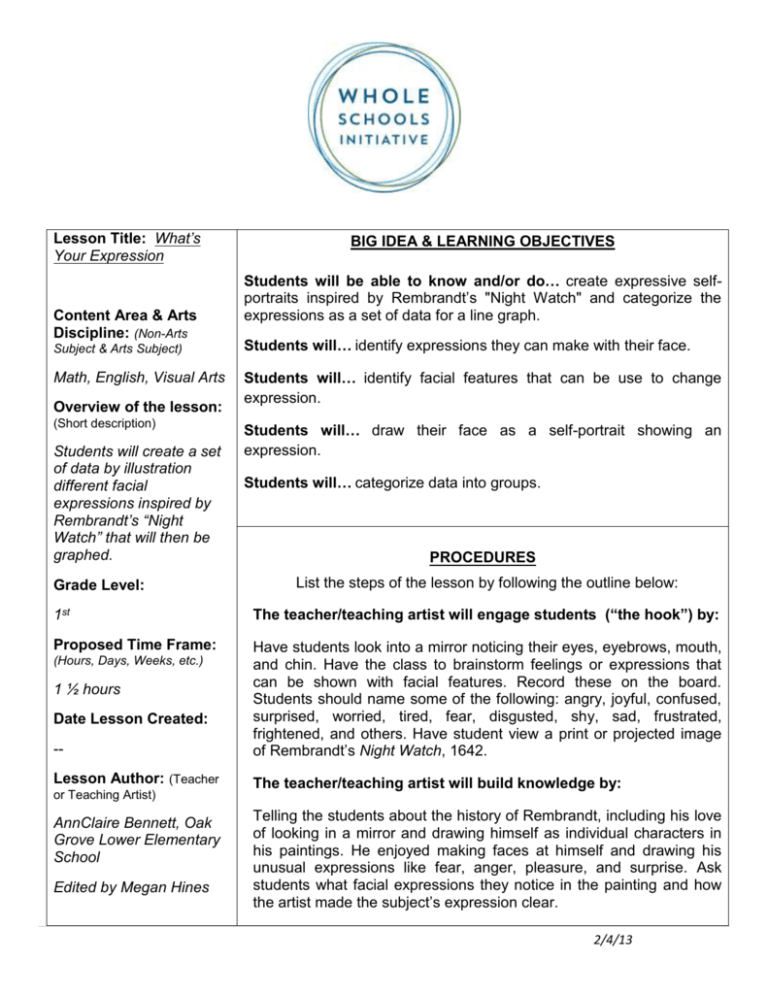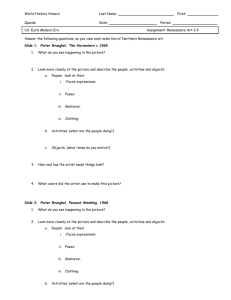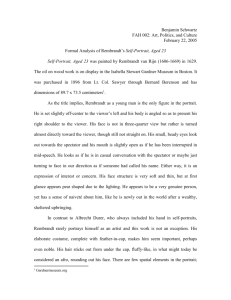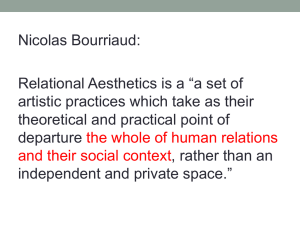What`s Your Expression - Whole Schools Initiative
advertisement

Lesson Title: What’s Your Expression Content Area & Arts Discipline: (Non-Arts Subject & Arts Subject) Math, English, Visual Arts Overview of the lesson: (Short description) Students will create a set of data by illustration different facial expressions inspired by Rembrandt’s “Night Watch” that will then be graphed. Grade Level: BIG IDEA & LEARNING OBJECTIVES Students will be able to know and/or do… create expressive selfportraits inspired by Rembrandt’s "Night Watch" and categorize the expressions as a set of data for a line graph. Students will… identify expressions they can make with their face. Students will… identify facial features that can be use to change expression. Students will… draw their face as a self-portrait showing an expression. Students will… categorize data into groups. PROCEDURES List the steps of the lesson by following the outline below: 1st The teacher/teaching artist will engage students (“the hook”) by: Proposed Time Frame: -- Have students look into a mirror noticing their eyes, eyebrows, mouth, and chin. Have the class to brainstorm feelings or expressions that can be shown with facial features. Record these on the board. Students should name some of the following: angry, joyful, confused, surprised, worried, tired, fear, disgusted, shy, sad, frustrated, frightened, and others. Have student view a print or projected image of Rembrandt’s Night Watch, 1642. Lesson Author: (Teacher The teacher/teaching artist will build knowledge by: (Hours, Days, Weeks, etc.) 1 ½ hours Date Lesson Created: or Teaching Artist) AnnClaire Bennett, Oak Grove Lower Elementary School Edited by Megan Hines Telling the students about the history of Rembrandt, including his love of looking in a mirror and drawing himself as individual characters in his paintings. He enjoyed making faces at himself and drawing his unusual expressions like fear, anger, pleasure, and surprise. Ask students what facial expressions they notice in the painting and how the artist made the subject’s expression clear. 2/4/13 The teacher/teaching artist will model the experience: Room Requirements & Arrangement: (Location of chairs, classroom or gym, etc.) Classroom Materials/Equipment: (Arts supplies, tech equipment, etc.) Hand held mirrors 4 1⁄4 x 5 1⁄2 sheet of paper Pencils Colored pencils Crayons Lined paper Resources: (Additional books, website addresses, images, etc.) Print of Rembrandt’s “Night Watch” or a projected image of the painting Vocabulary: (Key words for both the non-arts and arts subjects) Expression Rembrandt Angry Joyful Confused Surprised Worried Tired Fear Disgusted Shy Sad Frustrated Frightened The teacher will model the experience by showing the students example of how to create a drawn self-portrait that includes all of the facial features. This should keep details to a minimum so that students do not feel the need to copy the teacher example when making their own. The teacher should ask students how they would draw their own facial features and can use student answers to add to the portrait (this could include the color of student’s eyes, length of hair, a smile including recently lost teeth, etc.). The teacher/teaching artist will guide the practice with the students by: Ask students to practice showing these expressions in the mirror. After giving the students time to experiment, ask each child to select 1 expression from the list they generated on the board, and draw his/her face showing that expression. Ask each child to write the name of the expression at the bottom of the drawing, this will keep the students from changing the emotion as the class graph is being combined. The students will apply understanding by: After drawing the expression have each student complete one of the following sentences: The reason I look ________________ is ... I felt ________________ after... When the___________________________ happened I felt______... Use the students’ sketches to create an “Expression Graph”. Have students put glue on the back of their sketches and place in the correct expression category listed on the class bar graph. The teacher/teaching artist will create opportunities for reflection (Closing) by: Have students answer the following questions: -Which expression was drawn the most? -Which expression was drawn the least -Are any expressions drawn the same number of times? -How many is ______ and _______ together? -How many students drew the expression __________? After students complete their Expression Graph and answer the prompt questions, ask them to reflect on why they chose their expression and why they think Rembrandt enjoyed drawing facial expressions. Ask students to reflect on how they could add more details to their portraits to show expression in a way similar to the artist. 2/4/13 The teacher/teaching artist will assess the students’ learning by: Have each student share what he/she wrote to explain the facial expression on the drawing. Question the students to name the artist featured in this lesson. STANDARDS & PRINCIPLES Please list the competency from the following: State Content Standards (i.e. CCSS, Mississippi Frameworks): English Language Arts Speaking and Listening Standards 1. Participate in collaborative conversations with diverse partners about grade 1 topics and texts with peers and adults in small and larger groups. a. Follow agreed-upon rules for discussions (e.g., listening to others with care, speaking one at a time about the topics and texts under discussion). 5. Add drawings or other visual displays to descriptions when appropriate to clarify ideas, thoughts, and feelings. 6. Produce complete sentences when appropriate to task and situation. (See grade 1 Language standards 1 and 3 on page 26 for specific expectations.) Math Measurement and Data 1.MD Represent and interpret data. 4. Organize, represent, and interpret data with up to three categories; ask and answer questions about the total number of data points, how many in each category, and how many more or less are in one category than in another. Arts Standards (i.e. MS Visual & Performing Arts Frameworks): Visual Arts 1. Develop fundamental skills in using art media and processes to produce works of art. (CP) e. Use various media (e.g., paint, clay, ink, crayons, finger-paint, chalk, markers, pencil) to express different emotions in a work of art. f. Combine recognizable symbols for common objects (e.g., people, vegetation, houses, animals) to create an original expressive work of art. g. Produce drawings to create recognizable and expressive images. 5. Know that different works of art that evoke various descriptions and 2/4/13 responses.(CA) a. Know that works of art depict certain feelings. b. Understand and respond to how an artist may have chosen to depict certain feelings. c. Describe how the student’s own work depicts certain feelings. Principles of Universal Design for Learning (at least one from each of the three guiding principles): Provide Multiple Means of Representation 2.1 Clarify vocabulary and symbols 3.1 Activate or supply background knowledge 3.3 Guide information processing, visualization, and manipulation Provide Multiple Means of Action and Expression 5.2 Use multiple tools for construction and composition Provide Multiple Means of Engagement 7.1 Optimize individual choice and autonomy APPENDIX Extended Learning Activities: -TIPS/FAQs: -References: (i.e. Works cited, etc.) -- 2/4/13










